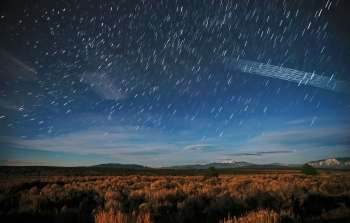sci22052 — Announcement
Addressing the Impact of Satellite Constellations on Astronomy: The Pathway Forward
June 10, 2022
By Connie Walker
Join us on Monday 13 June from 1:00 to 3:00 p.m. at the American Astronomical Society Meeting in Pasadena.
Learn about the progress to date toward mitigating the impact of constellation satellites on astronomy during the first 75 minutes of the splinter session. Discover plans for next steps and how to become involved, especially through the new IAU Centre for the Protection of the Dark and Quiet Sky from Satellite Constellation Interference (CPS). In the last 45 minutes of the splinter session, voice your thoughts, discuss concerns, and ask questions.
In May 2019 SpaceX opened a new era in the industrialization of space with the launch of the first tranche of Starlink satellites. Since then, the rapid growth of the number of satellites in low Earth orbit has created increasingly complex challenges for astronomy. The satellites' OIR trails and their radio transmissions will have major impacts; wide-field survey instruments such as Vera Rubin Observatory will be especially severely impacted by myriad satellite trails of reflected sunlight. Even if an astronomical image is free of a satellite trail, the overall brightening of the night sky by diffuse scattering of sunlight from satellites could impact every ground-based observation. The astronomy community urgently needed a multi-stakeholder and properly funded resource dedicated to the mitigation of these impacts. The CPS, launched on 1 April 2022 and co-hosted by the SKA Observatory and NSF's NOIRLab, is designed to fill that need.
In 2020 and 2021, two NSF-funded SATCON workshops and two United Nations-mandated Dark and Quiet Skies meetings carefully examined the challenges posed by extremely large fleets of satellites and developed recommendations for mitigation measures, as well as pathways to implement those recommendations. The CPS will pursue those implementations along multiple avenues, including a comprehensive satellite observing network, development of required software, research into hardware solutions, exchanges of community involvement, and creation of policy recommendations.
Satellites pose a severe, and for some facilities possibly existential, threat to astronomy, and industry is moving rapidly with launch and deployment. We must act now to preserve, to the greatest extent possible, the source of our data. Join us to hear about how the CPS has been organized, to learn about progress to date in mitigating the impacts of satellites on astronomy, to discuss concerns and ask questions, and to plan the immediate next steps.
About the Announcement
| Id: |
ID
sci22052
|
